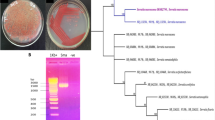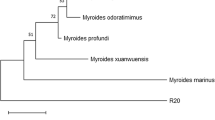Abstract
The aim of the present study was to understand the mineral phosphate solubilization (MPS) in Rhizobium sp. MR-54 (MPS+) by using forward genetic approach and its effect on nodulation as well as nitrogen accumulation on green gram. Tn5 mutants (MPS−) were generated from the MPS+ strain by Tn5 mutagenesis. Screening 1,603 colonies of MR-54::Tn5 resulted in identification of those mutants which failed to show any solubilization zone up to 72 h after incubation on Tri-calcium phosphate medium (TCP). pH drops and Pi release were highly correlated up to 15 days after incubation in TCP broth. Gluconic acid was detected in the culture supernatants of MPS+ isolates through thin layer chromatography indicating the presence of direct oxidation pathway in MR-54 strain. Detailed characterization of mutants was carried out for related properties like colony morphology, Pi release and pH change in TCP broth, organic acid production, surface characteristics and plant growth promoting ability etc. Mutants deficient in MPS showed reduced nodulation and nitrogen accumulation in green gram under green house conditions in leonard jar apparatus over the wild strain indicating the MPS by Rhizobium being involved in nodulation, nitrogen accumulation and plant growth.






Similar content being viewed by others
References
Hansan R (1996) Phosphorous status of soils in India. Crop Res Int J 10:2
Tirado R, Allsopp M (2012) Phosphorus in agriculture problems and solutions. Greenpeace Int 44:364–372
Scheffer F, Schachtschabel P (1988) Lehrbuch der Bodenkunde. Enke, Stuttgart
Halder AK, Mishara AK, Chakrabartty PK (1990) Solubilization of phosphatic compound by Rhizobium. Indian J Microbiol 30:311–314
Antoun H, Beauchamp CJ, Goussard N, Chabot R (1998) Potential of Rhizobium and BradyRhizobium species as plant growth promoting rhizobacteria on non-legumes : effect on radishes (Raphanus sativus L.). Plant Soil 204:57–67
Subba Rao NS (1984) Phosphate solubilizing microorganisms. Biofertilizers in agriculture, 2nd edn. Oxford and IBH publishing Co., New Delhi, pp 126–132
Halder AK, Chakrabartty PK (1993) Solubilization of inorganic phosphate by Rhizobium. Folia Microbiol 38:325–330
Kloepper JW, Lifshitz R, Zablotowicz RM (1989) Free-living bacterial inocula for enhancing crop productivity. Trends Biotechnol 7:39–44
Curl EA, Truelove B (1986) The rhizosphere. Springer-Verlag, Berlin
Ditta G, Stanfield S, Corbin D, Helinski DR (1980) Broad host range DNA cloning system for gram negative bacteria, construction of a gene bank of Rhizobium meliloti. Proceedings of National Academy of Science 77:7347–7351
Nautiyal CS (1999) An efficient microbiological growth medium for screening phosphate solubilizing microorganisms. FEMS Microbiol Lett 170:265–270
Jackson ML (1973) Soil chemical analysis. Prentice Hall of India Pvt Ltd, New Delhi
Cunningham J, Kuiack C (1992) Production of citric and oxalic acids and solubilization of calcium phosphate by Penicillium bilaii. Appl Environ Microbiol 58:1451–1458
Vincent JM (1970) A manual for the practical study of root nodule bacteria; IBP Handbook No. 15. Blackwell Scientific Publications, Oxford
Somasegarn P, Hoben H (1994) Methods in legume-rhizobium technology; NIFTAL project. University of Hawaii, Paia, Honolulu
Bremner JM, Keeney DR (1965) Steam distillation methods for determination of ammonia, nitrate and nitrite. Ann Clinica Chemica Acta 32:485–495
Nahas E (1996) Factors determining rock phosphate solubilization by microorganisms isolated from soil. World J Microbiol Biotechnol 12:567–572
Van Schie BJ, Hellingwerf KJ, van Dijken P, Elferink MGL, van Dij M, Kuenen G, Konings WN (1985) Energy transduction by electron transfer via a pyrrolo-quinoline quinone-dependent glucose dehydrogenase in Escherichia coli, Pseudomonas aeruginosa and Acinetobacter cafcoaceticus (var. fwofjcii). J Bacteriol 163:493–499
Gaur AC (1990) phosphate solubilizing microorganisms as biofertilizers, 1st edn. Omega Scientific Publishers, New Delhi. ISBN 81-85399-09-3
Rodriguez H, Fraga R (1999) Phosphate solubilizing bacteria and their role in plant growth promotion. Biotechnol Adv 17:319–339
Makino K, Shinagawa H, Amemura M, Kawanoto T, Yamada M, Nakata A (1989) Signal transduction in the phosphate regulation of Escherichia coli involves phosphortransfer between PhoR and PhoB protein. J Mol Biol 210:551–559
Wanner BL (1987) Phosphate regulation of gene expression in Esherichia coli. In: Neidhardt TC (ed) E. coli and Salmonella typhimurium cellular and molecular biology volume II. Harper and Row, Washington, pp 1326–1334
Chand L, Singh H (2006) Effect of phosphate solubilizers with different P-levels on yield and nutrient uptake of mung (Vigna radiata.) Research Council Meet Report, Division of Agronomy, SKUAST-K
Verma JP, Yadav J, Tiwari KN, Kumar A (2013) Effect of indigenous MesoRhizobium sp. and plant growth promoting rhizobacteria on yields and nutrients uptake of chickpea (Cicer arietinum L.) under sustainable agriculture. Ecol Eng 51:282–286
Almendras AS, Bottomley PJ (1987) Influence of lime and phosphate on nodulation of soil-grown Trifolium subterraneum L. by indigenous Rhizobium trifolii. Appl Environ Microb 53:2090–2097
Degerholm J, Gundersen K, Bergman B, Soderback E (2006) Phosphorus-limited growth dynamics in two Baltic Sea. FEMS Microbiol Ecol 58:323–332
Smith SE, Read DJ (2008) Mycorrhizal symbiosis, 3rd edn. Elsevier and Academic, New York, p 800
Sprent JI, Stephens JH, Rupela OP (1998) Environmental effects on nitrogen accumulation. In: Sumerfield RJ (ed) World crops: cool season food legumes. Kluwer Academic Publishers, Dordrecht, pp 801–810
Voisin AS, Salon C, Munier-Jolain NG, Ney B (2002) Effect of mineral nitrogen on nitrogen nutrition and biomass partitioning between the shoot and roots of pea (Pisum sativum L.). Plant Soil 242:251–262
Graham PH (1981) Some problems of nodulation and symbiotic accumulation in Phaseolus vulgaris L.: a review. Field Crops Res 4:93–112
Acknowledgments
Authors are grateful to Dr. Rajesh Gera, Principal Scientist, Department of Microbiology, College of Basic Science and Humanities, Chaudhary Charan Singh Agricultural University, Hisar who kindly gave the packed strains of Rhizobium; their time and effort is greatly appreciated. The first author is thankful to Jawaharlal Nehru University (JNU), New Delhi for providing fellowship during her Master’s program and Department of Biotechnology, University of Agricultural Sciences (UAS), Dharwad-580005, Karnataka, India for the financial support.
Conflict of interest
There is no conflict of interest to declare.
Author information
Authors and Affiliations
Corresponding author
Rights and permissions
About this article
Cite this article
Dahale, S.K., Prashanthi, S.K. & Krishnaraj, P.U. Rhizobium Mutant Deficient in Mineral Phosphate Solubilization Activity Shows Reduced Nodulation and Plant Growth in Green Gram. Proc. Natl. Acad. Sci., India, Sect. B Biol. Sci. 86, 723–734 (2016). https://doi.org/10.1007/s40011-015-0500-6
Received:
Revised:
Accepted:
Published:
Issue Date:
DOI: https://doi.org/10.1007/s40011-015-0500-6




